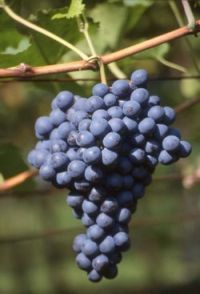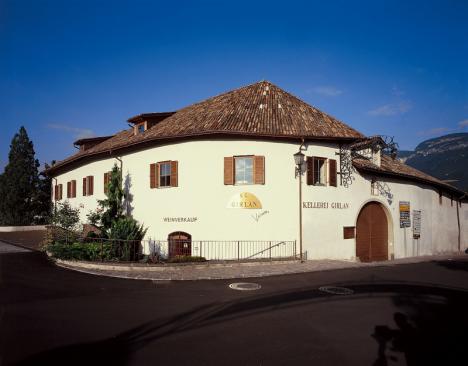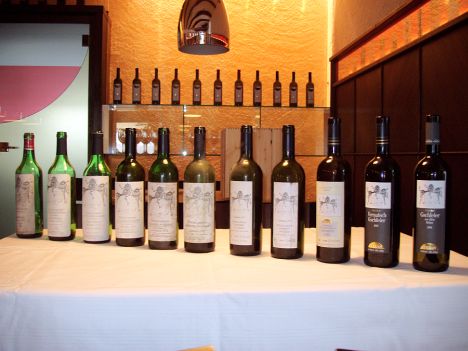 |
| A ripe Vernatsch grape% Source: www.laimburg.bz.it |
Vernatsch is generally regarded as a variety for light-coloured, everyday wines to be enjoyed young, which one would hardly expect to last longer than the barbecue season after next. More recently, however, South Tyrol has been making increasing efforts to press wines with a certain depth of character from the variety known in Germany as Trollinger, which, while being drinkable, should also satisfy higher demands and which can develop positively at least over a foreseeable period of time
Just how long this period can be was demonstrated on 31 March by the Girlan winery cooperative, which can be considered a pioneer among producers of high-quality Vernatsch. Since 1975, a single-vineyard Vernatsch has been produced here from the Gschleier vineyard, which was positioned as a top wine from the very beginning and hardly differed, if at all, in price from other prestige wines of the house. The vineyard is based on the site of an old Roman garrison, lies at an altitude of 430 metres and is one of Girlan's few south-facing sites. It is situated on a moraine hill with a soil of limestone, gravel and clay and is planted with vines that are now 80 to 100 years old. Here - without irrigation and chemical fertilisers - they produce a yield of 50 to 60 hectolitres per hectare, which is unusually low for Vernatsch.
After fermentation in steel tanks, the wine is put into large wooden barrels for 10 months and is then allowed to mature in the bottle for a few more months before being put on sale. The Gschleier, which is only produced in good years, often stands out in its youth with greater depth and complexity than one is used to from Vernatsch. In addition to the good location and the age of the vines, the relatively long ageing in wood is probably also responsible for this, which also makes itself felt with light vanilla and toasted tones and a stronger tannin structure than usual. This may expose the Gschleier to purists' reproach of not being entirely authentic, but the wine seems to tolerate the treatment very well, even benefiting from it.
 |
| The Girlan Winery |
This is especially evident in the long run, as the tasting in the cooperative's rooms impressively proved. 12 vintages were presented to a small circle of guests; the oldest wine was from 1976, the youngest was a barrel sample of the 2007 version. The result was more than surprising: the oldest wines were among the most convincing. The 76 reminded one of a perfectly matured Beaujolais Cru or Villages Burgundy and the 83 also shone with amazing vitality and mineral bite despite its cloudy colour. Even in the opened bottle, most of the old Vernatsch held up surprisingly well for several hours, a fact that could be seen again and again during the dinner, which was hosted by the restaurant "Zur Rose" in Eppan - one of the most excellent addresses in the area.
The vintages in detail:
1976 - a warm year, early harvest, fully ripe grapes
Clear ruby to fawn. Multi-layered aroma of dried red berries, especially rose hips, with notes of wilted leaves, leathery tones, slightly old woody and smoky aromas as well as mineral nuances. Relatively firm in the mouth, mature, but anything but old, certain juiciness, again also woody and also a little toasty aromas, delicate acid bite and certain minerality, slightly drying tannins, medium depth, good finish.
 |
| The Gschleier site |
1983 - a rather cool vintage with a lower sugar yield in the grapes and good acidity values
Somewhat dull, almost cloudy, but relatively dense garnet with slight brightening at the rim. Spicy, dense, a touch toasty and woody aroma of partly dried red berries and a hint of plums with delicate leathery hints. Taut and juicy in the mouth, relatively dense, ripe fruit with spicy and woody-roasty nuances, persistent on the palate, good complexity and depth, fine bite, mineral hints, seems surprisingly vital, very good finish with wilted floral aromas.
1985 - is considered an excellent year in South Tyrol, warm and early ripening
Clear garnet to fawn. Somewhat compote-like aroma of partly dried red berries with delicate malty and oxidative notes as well as toasty and wilted floral hints. Also very gently oxidative in the mouth, ripe red fruit, again a little wood and roasting, some drying tannin, dark caramel on the palate, spicy notes, not eternally deep, decent to good finish.
1989 - cool year, late harvest
Brilliant ruby-garnet with slight lightening. Amazingly fresh aroma of preserved and dried red and black berries with notes of wilted flowers and some foliage. Relatively fruity in the mouth, but also seems a little washed out, certain wood and toasty tones, some drying tannins, not too deep, decent, again slightly drying finish.
1990 - warm year with fully ripe grapes, but also good acidity
Slightly dull fawn brown. Aged, wood-spicy aroma of preserved red berries with toasty traces as well as mineral and herbal notes. Woody and slightly oxidative also in the mouth, relatively tightly woven, again mineral and herbal tones, spicy finish with slightly drying tannins and toasty aromas.
 |
| The protagonists of the day |
1995 - rather cool year with a warm September, late harvest, high acidity
Clear ruby-garnet. Lively, slightly mineral scent of red fruits and some black berries with notes of dried flowers. Slightly compote in the mouth, red berries, toasty hints, slightly drying tannin, quite persistent on the palate, has power and a certain juiciness, traces of wilted leaves and leather in the background, mineral hints, very good finish.
1997 - very warm year, particularly good red wine vintage
Somewhat dull garnet with fawn traces. Marmalade and a hint of sweaty scent of red berries and some wilted leaves. Woody and again reminiscent of wilted leaves in the mouth, restrained fruit, delicately smoky notes, drying tannin, some power on the palate, also slightly drying in the finish.
1998 - difficult year with rainy autumn
Bright, shiny garnet. Aroma of red berries and some plums with floral nuances. Slender in the mouth, rather cool, vegetal notes, a little drying tannin, not very deep, passable finish.
2000 - good year with "golden" autumn, relatively early harvest, good acidity levels
Ruby. Quite clear, red berry nose with floral and herbal nuances. Clear and straightforward in the mouth, red berries, some wood and slightly drying tannins, relatively tightly woven, mineral nuances in the background, slightly noticeable alcohol, good finish. Wins with air.
2005 - difficult year, ripening of the grapes only in good sites
Brilliant ruby. Straightforward in the nose, of red berries and some cherries, with cool floral tones in the background. Quite juicy in the mouth, red fruit and some minerality, delicate bite, good persistence on the palate, fine, slightly drying tannin, medium depth, animating, good finish.
2006 - warm summer despite rainy August, late harvest, fully ripe grapes
Youthful, shiny ruby. Straightforward nose, youthful, of red berries with distinct floral and slightly almondy tones. Red berry-fruity in the mouth, some floral and vegetal, woody tones on the palate, drying tannin, not too deep, decent finish.
2007 - very good year
(barrel sample)Fresh aroma of red berries, especially raspberries, with still slightly yeasty tones and floral nuances. Clear, juicy and lively in the mouth, some wood, fine bite, good persistence on the palate, harmonious, medium depth, good finish. Promising.